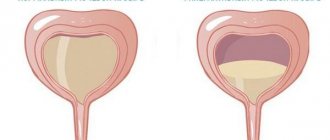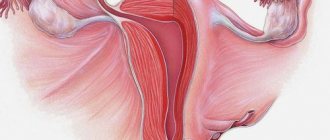Adrenal hyperplasia is a collective definition of a number of diseases associated with increased production of one or more hormones necessary to ensure metabolic processes in the body. The adrenal glands are part of the endocrine system and are two glands (asymmetrical in shape) that are located above the kidneys and are responsible for the production of the following hormones: cortisol, adrenaline, norepinephrine, aldosterone, androgen. Their structure consists of medulla and cortex. With the development of pathologies, changes most often occur according to this principle: the size of the cortex increases without deformation of the general outline, and the appearance of tumors is diagnosed in the medulla.
Causes
Adrenal dysfunction can be congenital or acquired. In the first case, the disease is usually inherited (a genetic malfunction in the body of one of the parents) or is formed under the influence of certain negative factors:
- frequent stress during pregnancy;
- taking antibiotics and other medications while pregnant;
- alcoholism, smoking abuse.
In the second case, when adrenal hyperplasia occurs during life, the disease becomes more active against the background of the patient’s unstable emotional background and constant nervous overstrain. Too much cortisol production begins, which leads to overload of the adrenal glands and, as a result, the development of various pathologies.
According to ICD-10, the disease is assigned code E27 “Other adrenal disorders.”
Treatment
Only the attending physician can prescribe treatment after conducting laboratory tests and taking tests. Self-medication with traditional methods will not help in this case. It is necessary to take medications that suppress the production of male hormones. Taking steroid glucocorticoids is effective. The dosage and course of administration are prescribed individually. Drugs in this group include Prednisolone, the daily dosage of which varies from 1.5 to 10 milligrams. It is recommended to divide the intake into two times. In case of intercurrent pathology, immediately take a double dosage for several days. During puberty, Prednisolone is taken only in the morning. In the afternoon, take Dexamethasone according to the instructions.
When adrenal hyperplasia occurs in a salt-wasting form, mineralocorticoids are taken in addition to hormonal drugs. The most commonly prescribed drug is Cortinef. Infants are additionally prescribed salt to compensate for sodium deficiency. In addition, patients taking cortisone acetate and hydrocortisone showed positive results. The greatest effect is achieved by combining several types of hormonal drugs.
Surgical intervention is advisable if the child has severe pathologies in the development of the external genitalia. The operation is performed in the first year of life, if health conditions permit. Hormone therapy may be prescribed to ensure proper formation of the genitals. Boys are prescribed medications containing androgens, and girls are prescribed medications with estrogens. In case of unilateral damage, an operation is performed to cut off the diseased organ. The operation does not require a long recovery period. A few days after removal of the adrenal gland, the patient is discharged from the hospital. For bilateral lesions, individual nodules are removed laparoscopically.
Symptoms
Since in most cases adrenal hyperplasia is associated with defects in the 21-hydroxylase molecule, to normalize the functioning of the cortex, the pituitary gland begins to produce adrenocorticotropic hormone above normal. As a result, there is an excess of male sex hormones in the body. Already in childhood, the following developmental anomalies may appear:
- too early hair growth of the genitals and armpits;
- pronounced acne that cannot be treated cosmetically;
- the appearance of bald patches at the temples;
- absence of menstruation in girls or late onset of menstruation (after 15 years);
- formation of a female figure according to the male principle (broad shoulders, lack of breasts, growth of excess facial hair).
You can read about the production of hormones by the adrenal glands here
As you get older, it becomes more difficult to recognize the disease without specialized diagnostics, since the symptoms of the pathology may vary depending on the types of adrenal gland pathologies. Common signs that should lead you to believe that problems are beginning are the following:
- Mental instability. It is characterized by causeless irritability, frequent mood swings, prolonged depression, and sudden outbursts of excitement.
- The appearance of stretch marks on the skin. The exception is sudden weight loss due to diet, pregnancy.
- Malfunctions of the gastrointestinal tract.
- The development of osteoporosis caused by metabolic disorders and poor absorption of calcium in the body.
- Blood pressure disorders, expressed in jumps from low to high.
- Decreased immunity even after taking immunomodulatory drugs.
- Obesity. As a rule, the main locations of excess fat are observed in the abdomen, neck, chin and cheeks.
- Muscle atrophy in the limbs.
- The appearance of primary signs of diabetes mellitus.
- Feeling constantly thirsty due to a violation of the water-alkaline balance.
- Frequent urge to urinate at night without signs of cystitis.
- Loss of clarity of thinking and memory lapses.
Treatment effectiveness
Doctors recommend that couples undergo screening before conceiving a child. After all, partners may not know that one of them is a carrier of a gene that causes congenital hyperplasia of the cortex of the endocrine glands - the adrenal glands. Despite the fact that CAH cannot be cured completely, if treatment therapy is prescribed correctly, a number of manifestations can be avoided. The patient suffers not only from the disease itself, but also experiences complexes. Therefore, it is important to diagnose adrenal pathology in childhood, while the reproductive system is just developing. Proper dosing of medications is also important, because you should not exceed the dose or skip a dose.
If a patient follows doctors' recommendations and does not refuse regular tests, he can significantly improve the quality of his life. In childhood, you can get rid of false signs and form a normal structure of the external genitalia. Even women who have the salt-wasting form can become pregnant and carry a child to term. The main condition is treatment under the supervision of doctors. There is a possibility that the baby will be born without manifestations of the disease if one of the parents does not suffer from CAH. But the child will be a carrier of the gene, and adrenal hyperplasia will appear in the descendants.
Types of congenital adrenal hyperplasia
There are several main types of congenital forms of the disease.
Hypertensive
Due to the excessive production of mineralcorticoids, androgens and cortisol, the kidneys cannot cope with the functions assigned to them, which leads to a number of external and internal changes.
In children, the disease manifests itself with the following symptoms:
- Unstable sleep.
- Increased intracranial pressure, which provokes severe headaches and vomiting.
- General lethargy and drowsiness.
- Disproportional volume of the skull.
- Asymmetrical development of the limbs.
Adult complaints are associated with the following symptoms:
- The appearance of small blood vessels on the face that cannot be removed by cosmetic methods (hardware, injection, manual).
- Dark circles under the eyes.
- Increased sensitivity to changes in atmospheric pressure.
- Decreased sexual desire or its complete absence.
- Excessive sweating even in the cold season.
- Cardiac arrhythmia.
- Rapid fatigue with minimal physical exertion and sports activity.
- Frequent migraines, especially in the evening and morning.
- Involuntary attacks of nausea and vomiting.
Virilny
This type of hyperalasia is characterized by a large release of androgen hormones into the body. Externally, the pathology manifests itself in the disproportionate growth of the genital organs in the direction of enlargement. At the same time, women's muscles develop in the likeness of men's, accompanied by increased hair growth on the body and face. Atrophy of the uterus and mammary glands is also observed, which subsequently leads to infertility. A secondary symptom of the disease is acne, which becomes chronic.
Salt-wasting
It is one of the most common congenital pathologies, occurring in 80 cases out of 100 in the examined patients. General symptoms: frequent gag reflex, feeling of thirst, lethargy and unemotionality, even with proper sleep and diet. With late diagnosis and improper treatment, children may develop short stature.
Girls experience:
- Hypertrophied clitoris.
- Fusion of the labia minora and labia majora.
- Lack of menstruation.
Boys experience:
- Increase in penis size.
- Presence of pigmentation in the scrotum area.
- Pubic hair growth at an early age (2-3 years).
- Voice breaking.
- Rapid gain of muscle mass in preschool age.
Hyperplasia in adults: what to do?
Adrenal hyperfunction is usually diagnosed in infancy, but adults also show signs of the disease. Adrenal hyperplasia in women is characterized by increased growth of pubic hair, low timbre of voice, acne, pain in the occipital region, night cramps, undeveloped breasts, increased blood pressure, and adrenogenital syndrome.
If you notice these symptoms, do not try to diagnose yourself. In these cases, folk remedies will not help either. Contact a doctor immediately. Hormonal treatment is required. Typically, women with this diagnosis are not recommended to plan a pregnancy. In many cases, it is even forbidden to give birth. Sometimes the best solution to the problem is the complete elimination of the diseased kidney, as well as all its appendages.
Other types of adrenal hyperplasia
Depending on the causes of occurrence and subsequent symptoms, several subtypes of adrenal hyperplasia are distinguished.
Nodular
Usually diagnosed in adolescents or athletes who abuse glucocorticoid drugs. With timely detection and proper therapy, the disease has a favorable prognosis for cure. General signs characteristic of this type of pathology:
- Heart rhythm disturbances (tachycardia/arrhythmia).
- Stretch marks in the thighs, chest and abdomen that look like reddish-purple smudges.
- A branched vascular network on the face, clearly visible in people with dry skin.
- Progressive osteoporosis of the extremities and all parts of the spine.
- Changing the oval of the face (giving it a moon-like shape).
- Excessive fat deposition in certain areas of the body (neck, abdomen).
- The appearance of age spots on the skin.
- Instability of the nervous system (depressive states, short-term periods of increased emotionality, isolation).
- Development of amenorrhea in women (lack of menstruation).
- Growth of facial hair (chin, upper lip, cheeks) in women.
Nodular
It is usually detected in adulthood, since the symptoms of the disease are vague and do not directly indicate the development of pathology. The cause of nodular hyperplasia lies in the increased content of adrenocorticotropic hormone in the blood. The glandular epithelium is transformed into benign formations, which tend to grow over time. Formed nodules can be single or multiple, affecting one or both adrenal glands. Signs indicating a problem:
- Increased skin pigmentation.
- Frequent attacks of migraines and dizziness.
- Unstable blood pressure.
- Malfunction of the kidneys.
- Tachycardia.
- Muscle weakening leading to partial atrophy.
- Short-term cramps of the limbs.
- Puffiness, bags under the eyes.
- The appearance of black spots before the eyes.
- Cases of loss of consciousness.
- General weakness, accompanied by a slight increase in body temperature.
- Frequent mood swings, states of euphoria, depression.
Important: in advanced forms of the disease, hormonal therapy is often ineffective, so surgery is performed to remove the affected gland. The production of necessary hormones is compensated by taking hormone-containing drugs on a lifelong basis.
Diffuse
A very difficult form of hyperplasia to diagnose, which is almost impossible to recognize on ultrasound. With this pathology, the endocrine gland does not change its shape, but increases in size. In the tissue of the adrenal cortex, nodules are formed that have a triangular structure and are overgrown with a fatty membrane. The disease is manifested by the following symptoms:
- Panic attacks, followed by complete indifference and depression.
- General muscle weakness in the absence of heavy physical activity.
- Cramps in the muscles of the limbs.
- Excessive urination.
- Constant thirst and dry mouth.
- Deterioration of vision.
- Frequent headaches.
- Hypertension.
- Testicular atrophy in men.
- Uterine bleeding in women.
- Infertility in women.
Diagnosis
All children with pathological abnormalities in the structure of the external genital organs must be tested for the presence of congenital adrenal hyperplasia. Modern examination techniques make it possible to determine elevated levels of substances already on days 2-5 from the moment the baby is born.
Taking an anamnesis is of great help in making the correct diagnosis. It has been noted that the disease is accompanied by the presence of similar pathological processes among relatives - approximately 30%. In addition it is noted:
frequent birth of large children whose weight exceeds 4 kg;
- sudden death of infants in the first months after birth;
- Newborns experience frequent regurgitation and vomiting.
A screening test is used for diagnosis. If you have a salt-wasting form of the disease, a blood test will reveal elevated potassium levels. In other cases, gonadotropin levels in newborns may be normal. However, over time, the amount of LH and FSH changes. This is typical for adult women with a similar diagnosis.
Also, in the presence of congenital pathology, bone age occurs ahead of schedule. This is detected by taking x-rays of the wrist joints. Additional CT or ultrasound reveals an increased volume of the adrenal glands. In this case, disturbances in the structure of the internal organs of the reproductive system are not detected.
Timely hormonal therapy of congenital pathological processes contributes to the normal sexual and physical development of a patient of any gender. For this reason, immediate action is required upon diagnosis. The goal of treatment, started at the earliest possible age, is to inhibit early puberty, premature growth arrest and ossification of epiphasic cartilages.
For females, treatment can be started at a later stage for the purpose of feminization. Male hyperplasia is subjected to steroid therapy until the epiphyses become fused. The need to resume treatment may arise at a more mature age, provided there is no spermatogenesis and testicular atrophy. Elimination of sterility is achieved by treatment with Cortisone.
To combat pathological disorders of reproductive function, with congenital adrenal hyperplasia, women are prescribed oral contraceptives. For this reason, detection of the first signs is a compelling reason to conduct an examination. Therapy with folk remedies in the presence of pathology of the adrenal cortex is ineffective.
Hyperplasia of the adrenal cortex
The disease is characterized by a decrease in the level of cortisol, which is responsible for the functioning of sex hormones. At the same time, there is an excess production of adrenocorticotropic hormone, which ultimately provokes the adrenal glands to increased synthesis of progesterone and estrogen. Externally, these disruptions in metabolic processes affect the human genital area. Namely:
- In girls/women there is an enlargement of the clitoris, in boys/men - in the penis.
- Hair growth increases in the armpits, pubic area, and legs. Typical for women.
- Bald patches appear on the temples and crown.
- The face is disfigured by acne.
- The skin begins to actively become pigmented, including in the genital area.
- In women, the voice becomes rough, the figure takes on a masculine appearance.
Hyperplasia of the medial crus
It belongs to the category of hereditary diseases that can be detected in the fetus in the womb using ultrasound. If the appropriate diagnosis has not been made, then we can talk about the existing pathology based on the following signs:
- Underdevelopment of the testicles in boys.
- Increased growth of genital organs in girls.
- Underdevelopment of the mammary glands in girls.
- Chronic acne on the face.
- Deepening of the voice in girls.
- Slow growth in children.
Usually the disease manifests itself immediately after the birth of a child or during his first year of life. Hyperplasia of the medial adrenal peduncle affects the reproductive function of the body without affecting the psycho-emotional state of the patient.
General symptoms
Signs of hyperplasia of the adrenal cortex are determined by the affected area of the glands. Various ailments may occur due to hormonal imbalance, but in general, any type of pathology is manifested by hypertension, cephalalgia, mental instability, and mood swings.
Common symptoms of adrenal disease include the following abnormalities:
- metabolic disorders in diabetes mellitus and obesity,
- osteoporosis,
- decreased protective properties of the body, frequent illnesses,
- myasthenia gravis,
- constant desire to drink, increased urination,
- digestive disorders,
- forgetfulness, confusion.
According to observations, girls and women are more susceptible to this pathology. In girls, parents notice abnormal development of the genital organs and distribution of hair according to the male androgenic principle. In boys and men, the disease manifests itself as Itsenko-Cushing syndrome. Diagnosing adults is much more difficult; sometimes the disease does not manifest itself at all.
Diagnostics
To determine the type of adrenal hyperplasia and further therapy, the following examination methods are used:
- Ultrasound.
- MRI.
- CT.
- Contrast X-ray examination of blood vessels (angiography).
- Radionuclide scanning.
- Dexamethasone tests.
- Enzyme immunoassay and radioimmunoassay.
- Histological tests.
- Aspiration punctures.
If necessary, other types of diagnostics can be performed to help make the correct diagnosis.
In the video, the surgeon talks in detail about modern diagnostic capabilities for adrenal diseases.
ICD 10 code
According to the ICD 10th revision, VGKN is allocated a place in class IV (E10–E90). Pathology belongs to the section “Diseases of the endocrine system, nutritional disorders and metabolic disorders.”
In class IV there is a section E20–E35 - “Disorders of other endocrine glands”, in which CAH is found under code E25, namely:
- E25 - adrenogenital disorders, includes heterosexual premature false puberty in women and men with adrenal hyperplasia, early macrogenitosomia, adrenal false hermaphroditism and female virilization;
- E25.0 - CAH associated with 21-hydroxylase deficiency causing salt loss;
- E25.8 - includes other adrenogenital disorders;
- E25.9 - adrenogenital syndrome NOS.
Treatment of adrenal hyperplasia is carried out with hormonal drugs. Glucocorticoids are usually used.
For virile and salt-wasting types, hydrocortisone, dexamethasone or prednisolone are prescribed. The dosage is selected so that 1/3 of the medicine is taken in the morning, and 2/3 in the evening. This is done to maximize the suppression of adrenocorticotropic hormones.
For the salt-wasting type, fludrocortisone is added to general therapy and the daily salt intake is increased to 3 grams.
Hirsutism and acne respond well to therapy with oral medications, for example, Diane-35 and others containing cyproterone. Epilation helps get rid of excess hair. The non-classical form of hyperplasia is treated only in the case of cosmetic defects, as well as in the development of infertility.
If damage to the adrenal glands is detected late and the female genital organs have already formed according to the male type, they resort to surgical plastic surgery with further use of hormones.












